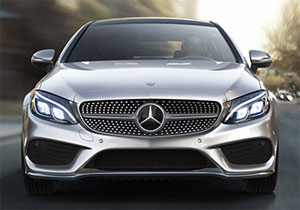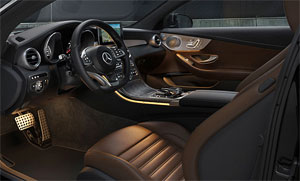2017 Mercedes-Benz C300 Coupe
2-door coupes have long sold at a fraction of the pace compared to the sedans they are usually based on. But, if German brands have their say, they are not likely to go away anyway soon. Over the years, they have perfected the art of the luxury sport coupe. And, now Mercedes-Benz adds fuel to that tradition with the new C300 coupe.
While the compact chassis that underscores this 2017 Mercedes-Benz C300 Coupe now carries all kinds of vehicles, this 2-door is by far the most dynamic looking of the bunch. Certainly more agile and muscular looking than its sedately appearing sedan stablemate.
The Coupe’s hood and grillwork are the same as the Sedan, but everything else is unique, including a lower roofline that makes almost one complete arch from A-pillar to tail.
Those hindquarters have much more in common with the larger S-class Coupe than the C-class Sedan; and due to sportier tuning, it sits about ½ and inch lower.
It’s a great-looking sculpture, clearly designed to be a true Coupe from the beginning and not a 2-door step child of a 4-door saloon.
The available Sport Package features a host of AMG add-ons for both the interior and exterior, and 19-inch AMG wheels can replace the standard 18s.
 The ubiquitous German 2.0-liter turbo-4 handles power delivery, sending 241-horsepower and 273 lb-ft. of torque to the rear wheels, or all four if you chose to go the 4MATIC route.
The ubiquitous German 2.0-liter turbo-4 handles power delivery, sending 241-horsepower and 273 lb-ft. of torque to the rear wheels, or all four if you chose to go the 4MATIC route.
It’s easily one of the better turbo-4’s out there right now, feeling more powerful than many V6s. Benz’s 7G-TRONIC 7-speed automatic transmission is your only route but it’s a good one.
Base suspension is equivalent to the Sedan’s sport setup, and ride quality is on the sporty side of comfortable; not harsh, and with just enough roll to keep it from feeling like you’re in a race car.
Still, smooth and steady are the themes here, more than quick and deadly. Upgrade to AIRMATIC suspension and you get sportier settings for even more aggressive maneuvering. Anything more, and you’ll have to wait for the AMG versions which are obviously on the way.
Most everything in the front compartment is straight C-class sedan, which is a good thing. There’s a great looking twin bezel gauge cluster, and lots of real knobs and buttons on the center stack; and a tacked on-style tablet just above.
The screen does look awkward, but it functions well through the COMAND controller.
There are minor trim updates, to go along with the obviously larger door panels.
 Front “sport seats” are unique to the Coupe, and are very comfortable with plenty of adjustments. Rear seat space and access are pretty much standard Euro-coupe. Its tight getting in, and only set up for 2 moderately-sized physiques. So you might want to just fold them down to expand a very tight 10.5 cubic-ft trunk.
Front “sport seats” are unique to the Coupe, and are very comfortable with plenty of adjustments. Rear seat space and access are pretty much standard Euro-coupe. Its tight getting in, and only set up for 2 moderately-sized physiques. So you might want to just fold them down to expand a very tight 10.5 cubic-ft trunk.
In track tests, despite a hefty feel, the C300 Coupe proved easy to point and shoot through the cones. Understeer became a problem as we pushed harder, but the rear didn’t so much as slide out as bounce around; as there always seems to feel like there’s some kind of electronic intervention present.
Steering was super-quick, but also a bit numb. Still, both that steering and overall performance felt sportier than the last BMW 4 series we sampled.
There’s also plenty of power to keep you satisfied; good thrust down low, and it keeps it up pretty well down the whole track. We hit 60 in 6.4-seconds.
Shifts happen very quickly and firmly; but better enjoy it while you can, Benz’s 9-speed will probably be coming shortly. All-in-all the car feels sneaky fast, quicker feeling than our 14.9-second ¼-mile time at 94 miles-per-hour.
A 120-foot average stopping distance from 60 is certainly acceptable. Pedal feel was nice and firm, and the car very stable.
Government Fuel Economy Ratings with all-wheel-drive are 23-City, 29-Highway, and 25-Combined. So, our 27.2 miles-per-gallon average of Premium was pretty good. But it only rates an average Energy Impact Score of 13.2-barrels of yearly oil use with 5.9-tons of CO2 emissions.
C300 Coupe prices start at $43,575; only a couple hundred dollars over a BMW 4 series Coupe, and we think well worth it. Add 2-grand more for all-wheel-drive.
In the past, owning a C-class Coupe or any C-Class really, clearly felt like you were settling for less than Benz’s best. Not anymore. The 2017 Mercedes-Benz C300 Coupe is a fantastic, sporty coupe; that, like the C-Class Sedan, now stands ready to take on all comers.
Specifications
- Engine: 2.0 liter
- Horsepower: 241
- Torque: 273 lb-ft.
- 0-60 mph: 6.4 seconds
- 1/4 mile: 14.9 seconds @ 94 mph
- EPA: 23 mpg city / 29 mpg highway,
- Energy Impact: 13.2 barrels of oil/yr
- CO2 Emissions: 5.9 tons/yr
2025 Volkswagen ID. Buzz
Volkswagen Brings Beetlemania Level Of Excitement To Minivan Segment
The duty of upholding Volkswagen’s heritage has most recently been delegated to small legacy car names like Golf and Jetta. But hold on! A much larger, totally modern take on VW’s classic microbus has just buzzed over the horizon— the all-electric ID. Buzz. It’s been at the top of our minds since we first saw the concept back in 2017. Well, it’s finally here, so let’s get our groove into drive!
This 2025 Volkswagen ID. Buzz has indeed created the most buzz around Volkswagen since the Beetle’s return to the U.S. in the late 1990s. We couldn’t drive it anywhere without drawing a crowd. No wonder, just about everyone has a VW Microbus story to tell, and seeing this reimagined version rolling down the street brings back all those memories.
VW really pulled it off as far as we’re concerned, as it looks great without appearing over the top. All the cues are here: Big VW logo front and center, lots of greenhouse including A-pillar windows and mini sliders for the second-row passengers, D-pillar air vents, and two-tone wheels. And while its appearance may be pure retro, its drivetrain is far from it, as the ID. Buzz is all-electric, and unlike the new Beetle, the Buzz does retain the original Microbus’ rear-drive architecture.
Powering those rear wheels is a 210-kW motor drawing juice from a 91-kWh battery for a range of 234 miles; 200-kW max charging will get you to 80% in about 26 minutes. Buyers can add another small 80-kW motor up front for 4motion all-wheel-drive and an increase of total output from 282 to 335 horsepower with a combined 512 lb-ft of torque. It uses the same battery, but range estimates drop just slightly to 231 miles. But while those numbers are modest, we also found them to be quite conservative, as we observed as many as 287 miles available in our all-wheel-drive tester’s gauge display and were on pace for 273 miles in our driving loop.
One throwback theme that may be a turnoff to some is that it’s quite a step up into the Buzz’s front seats, but there’s certainly a commanding view of the road once you climb in. Second row seating can be either a three-place bench or a pair of captain’s chairs, so there’s generous room for seven or six passengers. The captain’s chairs in our Pro S Plus offer good support and very easy access to the third row.
Lots of flexibility too with the option to simply fold the seats or remove them altogether.
With the sliding side doors and a wide opening rear hatch, there’s plenty of access for loading big sport utility amounts of cargo. Lots of flexibility too with the option to simply fold the seats or remove them altogether, and the ability to create a full-length flat floor with a rear cargo shelf that covers some handy removable storage bins. There’s 18.6 cubic-feet of space behind the third row, 75.5 behind the second, and a max of 145.5. That’s more than a Chevrolet Tahoe. For smaller items, there are lots of cubbies throughout the cabin, along with a standard Buzz Box that can be moved to multiple locations.
With a design that prioritizes retro form and modern function over aero efficiency, the 4motion equipped ID. Buzz earns a Fair efficiency rating, using 42-kWh of electricity per 100 miles, and we weren’t sure what to expect at our Mason Dixon test track.
What we found was great torque off the line and drama free launches to 60 in just 5.3 seconds. It was very stable at speed and power delivery stayed steady most of the way down the track until we reached about 90 mph, when it began to taper off just before we finished the quarter-mile in 14.0 seconds flat at 97 mph.
With 1,200-lbs. of battery weight nestled in its 127.5-inch wheelbase, the Buzz felt planted to the pavement through our handling course. There was quite a bit of body roll to deal with, but surprisingly little understeer. In panic braking runs, pedal response was inconsistent, feeling soft at times, pushing back hard at others; but through it all, results were quite good, stopping from 60 in an average of just 108 feet.
Three interior themes are available, this Dune is the brightest, featuring coastal inspired wood optic dash décor, “gray and clay” leatherette surfaces, and a high-mounted central 12.9-inch touchscreen. Pricing starts with a rear-wheel-drive Pro S at $61,545; this Pro S Plus begins at $65,045, add another $4,500 for 4motion, which brings a few extra features along with all-wheel drive.
Retro design with old-school VW charm, modern EV drivetrain, big SUV capacity merged with minivan flexibility; it all comes together in this 2025 Volkswagen ID. Buzz. It’s easily one of the coolest rides of the year and one that will likely keep Volkswagen dealers buzzing for years to come, and that’s something no other people and things mover can say.
Specifications
As Tested
- Motor Setup: Dual-Motor AWD
- Battery Size: 91-kWh
- Horsepower: 335
- Torque: 512 lb-ft
- EPA Range: 231 miles
- 0-60 mph: 5.3 seconds
- 1/4 Mile: 14.0 seconds at 97 mph
- Braking, 60-0: 108 feet
- MW Test Loop: ~ 273 miles













































